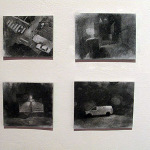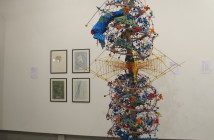In 1977, Richard Serra proposed that all drawing is the physical trace of doing, famously stating that "drawing is a verb." Let's call this our thesis. In 2002, curator Laura Hoptman claimed that, at the turn of the 21st century, "drawing is a noun," that works, at least those distilled for her MOMA exhibition Drawing Now, are "finished and autonomous." This will be our antithesis. And in a beautifully Hegelian moment of synthesis, enter the exhibition Expanded Marks. Including works of 15 member-artists from the Philadelphia-based, artist-run nonprofit Vox Populi and curated by its director Andrew Suggs, the exhibition proposes to conceptually reconcile thesis and antithesis by offering that drawing's ends are the gestures of its means—lines, smudges, movement—regardless of medium.
Two works by Leah Bailis subtly announce the show, set in SPACE Gallery's front window. Figure D (2009) is comprised of three exterior wall sections clad in clapboard, reduced in scale and executed in cardboard; the fitted edges between corner board, siding, and post are delineated as though with a pencil, indicating a trace of the work's fabrication. Figures A, B, C (2009) carefully renders each section in perspective, although the implied labeling does not obviously map image to sculpture, thus highlighting the limitations of fixed categorization—to wit, the boundaries that have circumscribed drawing's history—as well as the teleological tradition of drawing before sculpture. Considering these two works in conjunction, it is significant that drafting was an integral tool in the capacity for design's mechanization since the Industrial Revolution, just as clapboard siding came to be widespread with the era's mill technology.
In the front room, Gabriel Boyce's small, dense charcoal depictions of urban passage and Robert Chaney's silhouette of Midwestern industry provide a medium-bound sense of drawing. These are juxtaposed to Linda Yun's installation Incident (2009), in which a mass-produced light fixture illuminates strips of gold Mylar that are set in motion by an industrial-style floor fan, and James Johnson's neon sign Promise (2008) that scripts "I can give you everything you want." Yun's billowing polyester strands do generate perfectly ephemeral delineations and Johnson's writing is, indeed, a form of mark-making, also fleeting (neon, after all, a gas), but also tired in its irony. More substantially, this room's works manifest tensions between American values and current economy. For Promise, this theme was more evident when it was exhibited last year in Philadelphia, for one could read it through the miniature windows of Johnson's installation House—although, then again, no more "house" seems fitting for an exhibition these days. Jamie Dillon's piece—a gong with the spray painted inscription FUCK "THIS" PLACE—was also part of a larger installation when it debuted in May, but such loss of completion speaks to the show's vision of drawing as neither rough and intermediate or final and polished, but in which its ends are itself unfinished.
Mark-making expands in the exhibition to explore the ecological and political traces humans leave on the natural environment: Micah Danges's photos of lush nature scenes are overlaid with smoky clouds and tints of added color; Anita Allyns video The Falls (2009) depicts a saturated, saccharine waterfall scene. In a voiceover, Jimmy Carter speaks an excerpt from one of his 1977 speeches— "It is a changing world, a different world… at peace with other nations and also at peace with itself"--while the riverwater flows backwards.
The exhibition's sense of environment and its relation to imprint also includes landscape as social and psychological. Brent Wahl's video Tear/Tear (2006) records a teardrop/blood drop/vaguely phallic form bouncing on a surface, leaving no mark as it hits, although its signifieds certainly do. Nick Paparone's posters of a well-oiled Cindy Crawford in a yellow bathing suit, to which Paparone has appended to her head oversized yellow fruits to match, provides a cheeky comment on how beauty is delineated, socially and aesthetically—and in keeping with the theme of the "mark," of course few have a more famous beauty mark than Crawford.
Only Paparone and his sometimes-collaborator Joshua Rickards offer figurative works, formally engaging drawing's relationship to the popular cultures of advertising and comics. Rickards furnishes the cartoonish Services (2009) by basically using his paintbrush as a pen. A plaid shirt against multicolored diamond pattern confronts the historical trope that drawing privileges line over color—as well as the West's generally banal taste for, and deprecation of, ornament.
Expanded Marks does provide conceptual distance from the near-categorical imperatives that have historically haunted drawing, but it does so primarily by generating new categories rather than questioning the practice of classification. Perhaps this is a passé criticism: Deconstruction is over, you say? But too often the works feel foremost like new illustrations for a new ontology, or for a transcendent Dictionary of Drawing, Revised Edition.
- Installation view of Expanded Marks.
- Joshua Rickards, Services, acrylic, oil, and flashe on panel, 2009 & Joshua Rickards, AAW, DFR, HED, flashe and oil on panel, 2009.
- Gabriel Boyce, Clockwise from top left: 15th and Cherry; Alley; White Van; Loading Dock, Charcoal on paper, 2009.
"Expanded Marks" was on view until July 23rd, 2009, at SPACE Gallery, located at 538 Congress St. in Portland, ME.
All images are courtesy of the artists and SPACE Gallery.







